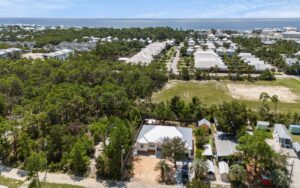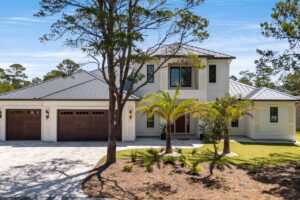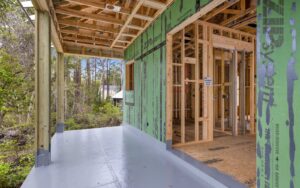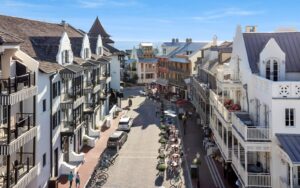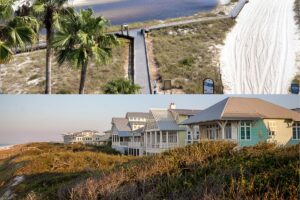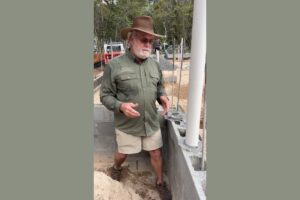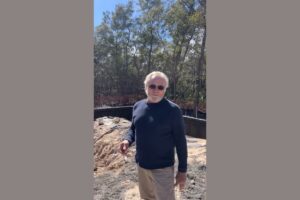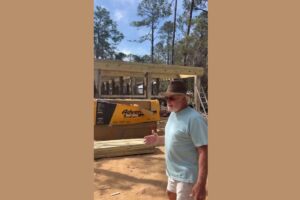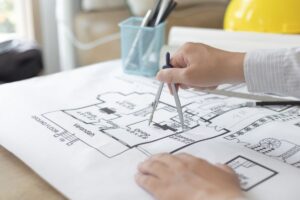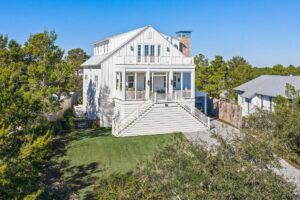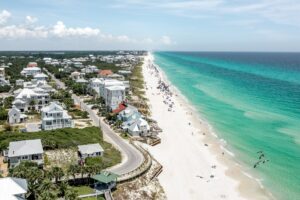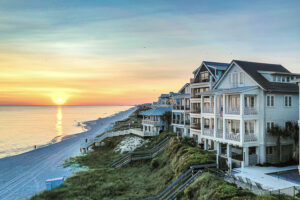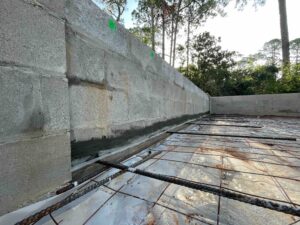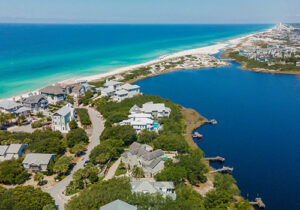Table of Contents
- Introduction
- Overview of the 30A Area and Its Appeal for Custom Homes
- Importance of Building a Custom Home in 30A
- Section 1: Finding the Right Location
- Section 2: Choosing a Custom Home Builder
- Key Qualities to Look for in a Custom Home Builder
- Questions to Ask Potential Builders
- Overview of Grahame Family 30A Custom Home Builders' Unique Approach
- Section 3: Understanding Building Codes and Exceeding Them
- Explanation of Standard Building Codes
- Benefits of Building Beyond Code
- Examples of Building Practices That Go Beyond Code
- Section 4: The Home Building Process
- Step-by-Step Guide from Initial Planning to Final Construction
- Importance of Blueprints and Architectural Designs
- Collaboration with Interior Designers
- Section 5: Financial Planning and Budgeting
- Overview of Construction Loans and Financing Options
- Tips for Budgeting and Managing Costs
- Importance of a Contingency Fund
- Section 6: Sustainable and Energy-Efficient Building Practices
- Benefits of Sustainable Building Materials and Practices
- Examples of Energy-Efficient Technologies and Materials
- How Sustainability Enhances Long-Term Value and Reduces Costs
- Section 7: Customization and Personalization
- Section 8: Living in the 30A Area
- Overview of the Lifestyle and Amenities Available in 30A Communities
- Highlighting Local Attractions, Events, and Activities
- Testimonials from Residents and Homeowners
- Conclusion
Building a custom home along the picturesque 30A coast is a dream for many. This guide will take you through the essential steps and considerations, ensuring your journey from concept to completion is as smooth and rewarding as possible. Here’s how we’ll break it down:
Overview of the 30A Area and Its Appeal for Custom Homes
The 30A area, nestled along Florida’s Emerald Coast, is renowned for its stunning beaches, charming communities, and vibrant local culture. Spanning roughly 20 miles, 30A is home to a series of small, idyllic beach towns, each with its unique character and appeal. From the upscale elegance of Alys Beach to the laid-back vibe of Grayton Beach, the diversity of the 30A area makes it a prime location for building a custom home.
Living in 30A offers unparalleled access to pristine white-sand beaches, crystal-clear waters, and a variety of outdoor activities such as biking, paddleboarding, and hiking. The area is also known for its excellent dining options, boutique shopping, and frequent local events that foster a strong sense of community. For those looking to escape the hustle and bustle of city life, 30A provides a serene and picturesque setting that’s perfect for a custom-built home tailored to your specific needs and lifestyle.
Importance of Building a Custom Home in 30A
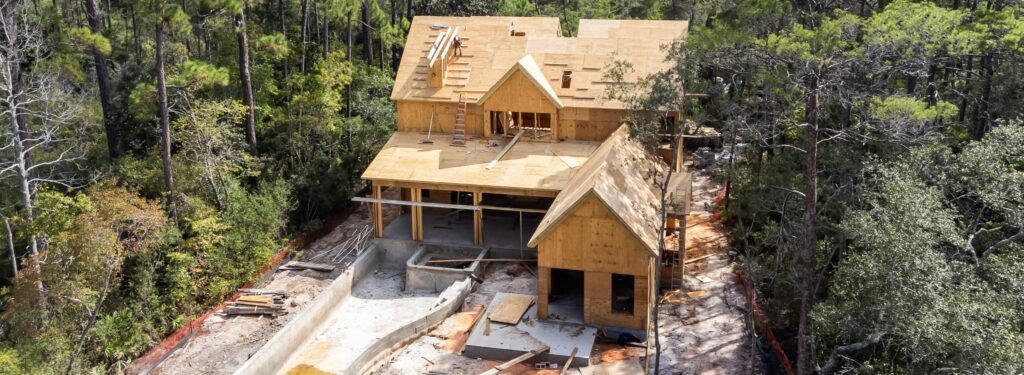
Building a custom home in 30A allows you to create a living space that perfectly reflects your personal style and meets your unique needs. Unlike purchasing a pre-built home, a custom home gives you the freedom to choose every detail, from the layout and architectural style to the finishes and fixtures. This helps make your home not only beautiful but also functional and suited to your lifestyle.
Moreover, a custom home built beyond standard codes can offer enhanced safety, durability, and energy efficiency, which are particularly important in a coastal area prone to extreme weather conditions. By investing in high-quality materials and advanced building techniques, you can help your home stand the test of time and provide a comfortable living environment for years to come.
Finding the Right Location
Choosing the right location for your custom home is crucial in the building process. The 30A area offers a variety of communities, each with its unique charm and amenities. Here’s a closer look at some of the most popular communities in 30A:
Dune Allen Beach is known for its quiet, laid-back atmosphere and beautiful coastal dune lakes. It’s a perfect spot for nature lovers who appreciate scenic views and outdoor activities. The community offers easy access to Topsail Hill Preserve State Park, known for its pristine beaches and diverse wildlife.
The Retreat is a gated community offering an exclusive, tranquil environment. Nestled on the west end of 30A, it features luxury homes with private beach access, a community pool, and walking trails through natural landscapes. It’s ideal for those seeking privacy and upscale living.
Forest Lakes stands out with its beautiful, tree-lined streets and family-friendly atmosphere. The community boasts a variety of amenities, including a large community pool, fishing lakes, and picnic areas. It’s perfect for families looking for a safe and serene environment.
Cypress Dunes is renowned for its natural beauty and conservation-focused design. Adjacent to Topsail Hill Preserve, the community offers stunning views of the dunes and Gulf of Mexico. Amenities include an infinity-edge pool, clubhouse, and fitness center, making it a great choice for those who enjoy luxury living in harmony with nature.
Cypress Breeze features resort-style amenities and a vibrant community feel. It’s known for its impressive lagoon pool, which is the largest community pool on 30A. The community is also close to the beach and offers easy access to the shopping and dining options of Gulf Place.
The Hammocks offers a secluded, peaceful setting with easy access to the beach. The community features beautiful homes surrounded by mature trees and natural landscapes. It’s perfect for those looking for a quiet retreat within reach of 30A’s amenities.
Draper Lake is a unique, gated community designed to blend seamlessly with its natural surroundings. The community is centered around the stunning Draper Lake, offering residents access to paddleboarding, kayaking, and scenic nature trails. It’s ideal for nature enthusiasts and those seeking a tranquil lifestyle.
Gulf Place is a vibrant, mixed-use community known for its lively atmosphere and convenience. It features a variety of shops, restaurants, and art galleries, along with public beach access and community events. It’s perfect for those who enjoy an active, social lifestyle.
Point Washington offers a blend of historic charm and natural beauty. Located near the Choctawhatchee Bay, the community is known for its large, wooded lots and proximity to Eden Gardens State Park. It’s ideal for those who appreciate a more rural, serene setting.
Santa Rosa Beach is a well-established community offering a mix of old Florida charm and modern amenities. It’s known for its beautiful beaches, diverse dining options, and vibrant arts scene. It’s a great choice for those looking for a balanced lifestyle with access to both nature and culture.
Inlet Beach is the easternmost community on 30A, offering a more relaxed, spacious environment. It features some of the largest and most secluded beaches in the area. The community is rapidly growing, with new shops and restaurants adding to its appeal.
Watersound is a master-planned community known for its stunning architecture and pristine natural surroundings. It offers a variety of amenities, including private beach access, community pools, and walking trails. It’s perfect for those seeking a luxurious, nature-focused lifestyle.
Seacrest Beach is known for its family-friendly atmosphere and beautiful, well-maintained properties. The community features the largest pool in Northwest Florida, a variety of shops and restaurants, and easy beach access. It’s ideal for families and vacationers.
Seaside is famous for its charming pastel-colored homes and pedestrian-friendly design. This community is great for those who value a tight-knit community feel and classic beach town charm. It’s known for its cultural events, farmers market, and iconic beach pavilion.
Seagrove offers a blend of classic and contemporary beach living. It’s known for its towering oak trees, beautiful beaches, and diverse dining options. The community has a laid-back vibe but offers all the modern amenities one might need.
Alys Beach is an upscale, meticulously planned community known for its striking white-washed architecture and luxurious amenities. It features beautifully landscaped streets, a private beach club, and numerous parks and green spaces. It’s ideal for those seeking a sophisticated, high-end lifestyle.
Rosemary Beach stands out for its European-inspired architecture, cobblestone streets, and vibrant town center. It’s ideal for those who enjoy a bustling, community-oriented lifestyle with plenty of dining and shopping options. The community is designed to be walkable, with all amenities easily accessible.
WaterColor offers a blend of natural beauty and upscale living. With its well-manicured parks, scenic trails, and proximity to Western Lake, it’s perfect for families and outdoor enthusiasts. The community features a range of amenities, including a beach club, multiple pools, and a boathouse.
Grayton Beach exudes a quirky, artistic vibe and is known for its eclectic mix of homes and vibrant local culture. It’s a haven for creatives and those who appreciate a more laid-back, bohemian lifestyle. The community is adjacent to Grayton Beach State Park, offering ample opportunities for outdoor recreation.
Blue Mountain Beach is named for its towering blue lupine flowers and offers the highest elevation along 30A. It’s known for its stunning views, peaceful atmosphere, and access to both the Gulf and nearby coastal dune lakes. It’s perfect for those seeking a quiet, scenic setting.
Factors to Consider When Choosing a Location
When selecting the perfect location for your custom home, consider the following factors:
- Proximity to Amenities: Ensure that the chosen community provides access to the amenities most important to you.
- Lifestyle Preferences: Choose a community that aligns with your lifestyle, whether you prefer a quiet, nature-focused environment or a vibrant, active community.
- Future Growth: Consider the potential for future development in the area, which could impact property values and the overall appeal of the community.
- Accessibility: Ensure that the location is easily accessible by major roads and offers convenient travel options during periods of peak occupancy.
- Community Vibe: Spend time in various communities to get a feel for their unique atmospheres and decide which one best suits your personal preferences and lifestyle.
By carefully considering these factors, you can find the perfect location in 30A to build your dream custom home, ensuring it not only meets your needs today but also offers long-term satisfaction and investment.
Choosing a Custom Home Builder
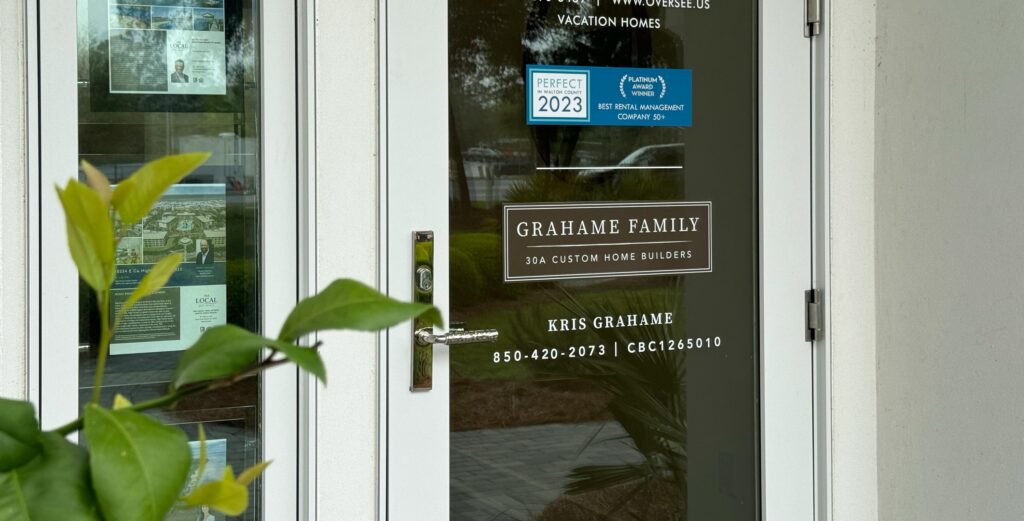
KEY QUALITIES TO LOOK FOR IN A CUSTOM HOME BUILDER
Experience and Expertise
Experience is a critical factor when choosing a custom home builder. Builders with a long history in the industry have likely encountered and overcome various challenges, equipping them with the knowledge and skills needed to handle complex projects. Look for builders with a proven track record of successful projects in the 30A area.
Reputation and References
A reputable builder will have positive reviews and testimonials from previous clients. Ask for references and contact them to learn about their experiences. Look for builders who are known for their reliability, quality of work, and customer satisfaction.
Quality of Workmanship
Examine the builder’s portfolio to assess the quality of their previous projects. High-quality workmanship is essential to help your home be not only beautiful but also durable and functional.
Transparency and Communication
Effective communication is crucial to a successful home-building process. Choose a builder who is transparent about costs, timelines, and potential challenges. They should be willing to listen to your ideas and provide regular updates on the progress of your project.
Customization and Flexibility
A good custom home builder should be flexible and willing to accommodate your specific needs and preferences. They should offer a range of customization options and be able to adapt their plans to suit your vision.
Questions to Ask Potential Builders
- What is your experience with building custom homes in the 30A area?
- Can you provide references from previous clients?
- What is your process for handling design changes and customizations?
- How do you ensure the quality of your workmanship?
- What are the estimated timelines and costs for my project?
- How do you handle unexpected challenges or delays?
- Do you offer any warranties or guarantees on your work?
- Can you provide a detailed, written contract outlining the scope of work?
Overview of Grahame Family 30A Custom Home Builders’ Unique Approach

At Grahame Family 30A Custom Home Builders, we pride ourselves on our commitment to excellence and personalized service. Here’s what sets us apart:
Extensive Experience
With over 45 years of experience in the construction industry, we have built a wide range of custom homes, from energy-efficient full basement homes in Denver, Colorado, to luxurious three-story beach homes in Florida. Our extensive experience ensures that we have the expertise to handle any project, regardless of its complexity.
Reputation for Quality
We have a strong reputation for delivering high-quality workmanship. Our homes are built to exceed standard building codes, which enhances safety, durability, and energy efficiency. We recommend the best materials and construction techniques to create homes that stand the test of time.
Personalized Service
We understand that building a custom home is a deeply personal journey. That’s why we work closely with our clients to understand their vision and bring it to life. From the initial consultation to the final walkthrough, we ensure that our clients are involved and informed every step of the way.
Transparent Communication
We believe in maintaining open and transparent communication with our clients. We provide detailed cost estimates, timelines, and regular progress updates. Our goal is to ensure that there are no surprises and that our clients feel confident and informed throughout the building process.
Flexibility and Customization
Every home we build is unique, tailored to the specific needs and preferences of our clients. We offer a wide range of customization options and are always willing to adapt our plans to meet the unique requirements of each project.
By choosing Grahame Family 30A Custom Home Builders, you can rest assured that your dream home is in the hands of experienced professionals who are dedicated to delivering exceptional quality and personalized service.
Understanding Building Codes and Exceeding Them
Building codes are essential for ensuring the safety, health, and general welfare of the occupants of a building. They provide a set of standards that construction projects must adhere to, covering various aspects of building design, materials, construction techniques, and safety measures. Understanding these codes and the benefits of exceeding them can significantly impact the quality and longevity of your custom home.
Explanation of Standard Building Codes
Building codes are regulations that set minimum standards for construction to ensure the safety and health of occupants. In the United States, the most widely used building code is the International Building Code (IBC), which is developed by the International Code Council (ICC). The IBC covers a wide range of construction aspects, including structural integrity, fire safety, plumbing, electrical systems, and energy efficiency.
KEY PURPOSES OF BUILDING CODES:
- Safety: Ensuring the structural integrity of buildings to withstand natural disasters such as earthquakes, hurricanes, and floods.
- Health: Protecting the health of occupants by setting standards for plumbing, ventilation, and indoor air quality.
- General Welfare: Ensuring accessibility for people with disabilities and providing guidelines for energy efficiency to reduce environmental impact.
BENEFITS OF BUILDING BEYOND CODE
While building codes set the minimum standards, building beyond these codes can offer numerous benefits that enhance the overall quality and value of your custom home.
Enhanced Safety:
Building beyond code involves implementing additional safety measures that exceed the minimum requirements. This can include using stronger materials, adding more structural reinforcements, and incorporating advanced fire suppression systems. These measures significantly reduce the risk of structural failures and provide greater protection against extreme weather conditions.
Increased Durability:
Homes built to exceed standard codes are designed to last longer and withstand various environmental stresses. By using high-quality, durable materials and advanced construction techniques, you can help your home remains in excellent condition for many years, reducing the need for frequent repairs and maintenance.
Improved Energy Efficiency:
Exceeding building codes often involves integrating the latest energy-efficient technologies and materials. This can include better insulation, high-performance windows, and energy-efficient HVAC systems. Improved energy efficiency not only reduces utility bills but also lessens the environmental impact of your home, contributing to sustainability efforts.
Higher Resale Value:
Homes built beyond code are more attractive to potential buyers due to their enhanced safety, durability, and energy efficiency. This translates into a higher resale value, as buyers are willing to pay a premium for homes that promise lower maintenance costs and better living conditions.
Overall Value:
Building beyond code enhances the overall value of your home by ensuring it is safer, more durable, energy-efficient, and environmentally friendly. This approach provides peace of mind, knowing that your investment is protected and built to the highest standards.
EXAMPLES OF BUILDING PRACTICES THAT GO BEYOND CODE
While standard codes require basic structural elements to withstand certain loads, building beyond code might involve using reinforced concrete, additional bracing, and advanced anchoring systems to ensure maximum stability and resistance to extreme conditions.
Standard codes require basic insulation to achieve a minimum level of energy efficiency. Exceeding these standards could involve using high-performance spray foam insulation, rigid foam boards, or insulated concrete forms (ICFs), which provide superior thermal performance and reduce energy consumption. Also, air sealing the building enclosure to reduce air infiltration through floor, wall and roof assemblies significantly contribute to improved indoor comfort and energy savings, as well as reduced insect intrusion.
Florida codes specify minimum window and door U-valves (insulation) and solar heat gain coefficients (SHGC/radiation) values, and wind and water resistance rating requirements. Appropriate selection of high performance window and door features such as Low-E coatings (control radiation), low U-values, and increased wind and water resistance significantly improves their thermal performance by reducing heat gain/loss which improves indoor comfort, saves energy, and are more resistance to hurricane force winds. Lower SHGC also greatly reduces fading of interior furniture and finishes.
Although Florida Code requires a vapor barrier under slabs-on-grade and weather resistant barriers (WRB) on exterior walls and roof assemblies, how these barriers are installed and the materials used determine the performance and durability of the building enclosure. Intrusion of water into the building assembly is the number one destroyer of buildings. Properly constructed vapor and moisture barriers using appropriate climate specific building materials is essential.
Managing ground and bulk (rain) water under the slab foundation and within or on the wall and roof assembly requires a properly installed higher grade vapor or moisture barrier material, and capillary break of gravel under the slab, and a rain screen behind exterior claddings (siding/brick/succo/etc…), flashings, and an appropriately installed roof membrane to control water is essential in building a durable structure.
If you want a healthy, comfortable, durable, energy efficient indoor living environment then you have to control the air, heat, and moisture flow through the building assembly (floors/walls/roof). This requires an air tight house that is extremely well insulated with a properly designed fresh air exchange and HVAC system.
Building an air tight, well insulated and water managed building enclosure is essential before designing and installing an HVAC system. A properly designed HVAC system needs to include the following equipment components:
- Heating system
- Cooling System
- Filtration System
- Humidity Control
- Ventilation – Fresh Air Exchange
A properly sized and installed hvac system requires an HVAC mechanical engineer to design the system and recommend equipment, and an HVAC contractor to install the system for proper air distribution.
Standard codes may not require the use of sustainable materials. Selecting appropriate climate specific building materials, systems and technologies is critical to the long term durability and performance of the building. Building materials that are not well suited for the climate will lead to increased maintenance and consequently premature deterioration and failure. Salt air, moisture, and the sun’s UV will cause significant damage to building materials not suited for the coastal climate. Architects, designers and builders can help with the selection of more durable building products and materials for the long term durability of the building.
By building beyond code, you ensure that your custom home not only meets but exceeds the highest standards of safety, durability, and energy efficiency. At Grahame Family 30A Custom Home Builders, we advise implementing these advanced building practices to provide our clients with homes that offer unparalleled quality and value.
The Home Building Proces
Building a custom home is an exciting journey that involves several critical stages from initial planning to the final touches. Understanding each step of this process helps ensure that your project stays on track and meets your expectations. Here’s a step-by-step guide to the home building process, emphasizing the importance of blueprints, architectural designs, and collaboration with interior designers.
STEP-BY-STEP GUIDE FROM INITIAL PLANNING TO FINAL CONSTRUCTION
The home building process begins with an initial consultation where you discuss your vision, needs, and budget with the builder. This stage defines the project scope and sets clear goals. When you start the process with the guidance of an experienced builder you have crucial help navigating the planning phase of the project ensuring that your build site, house design and budget accurately reflect your vision.
Choosing the right location for your custom home is crucial. The builder will help you evaluate potential sites based on factors such as zoning, topography, accessibility, and utilities. This stage might also involve conducting soil tests and site surveys to ensure the chosen location is suitable for construction.
This phase involves creating detailed blueprints and architectural designs. Working with an architect, you’ll develop a floor plan that meets your needs and preferences. This includes deciding the number of rooms, their placement, and the overall flow of the home. The architect will work with you to design the exterior of the home, choose the placement on the build site and ensure the designs comply with local building codes and regulations. Once architectural drawings are far enough along an engineer will design the structural components of the build.
Before construction can begin, it’s essential to obtain the necessary permits and approvals from local authorities. This ensures that the project complies with zoning laws, building codes, and other regulations. It is crucial to have a builder with experience obtaining permits where your build will be located due to the vast differences between jurisdictions.
Site preparation often involves clearing, grubbing, dewatering, leveling, and soil retention. This stage is crucial for ensuring the stability and durability of the home. Once your site is prepped the surveyor will lay out the foundation of your home so you are ready to begin construction.
The foundation is a critical component of the home’s structure. Depending on the site and design, this could involve pouring a concrete slab, a block stem-wall or erecting pilings. Ensuring the foundation exceeds standard building codes can enhance the home’s durability, resilience and set the tone for the rest of the build.
Framing involves constructing the skeleton of the home, including walls, floors, and the roof. This stage defines the shape and size of the home and includes installing windows and doors, roof underlayment and weather barriers.
Once the frame is complete, the next step is to install essential mechanical systems such as plumbing, electrical, and HVAC. These systems must be carefully designed and integrated into the structure to ensure comfortability, air quality, and efficiency.
Insulation is crucial for energy efficiency and comfort. The importance of insulation and air and moisture sealing cannot be overstated. After installing insulation, drywall is put up to form the interior walls and ceilings.
This phase involves adding exterior elements such as siding, roofing, and paint. These finishes not only enhance the home’s aesthetic appeal but also protect it from the elements.
Interior finishes include carpentry, flooring, tile, cabinetry, countertops, and fixtures. This stage is where the home starts to reflect your personal style and preferences.
Before moving in, the home undergoes final inspections to ensure everything is built to code and meets quality standards. A walkthrough with the builder allows you to identify any final adjustments or touch-ups needed.
Once all inspections are passed and final touches are completed, it’s time to move in and enjoy your new custom home.
IMPORTANCE OF BLUEPRINTS AND ARCHITECTURAL DESIGNS
Blueprints and architectural designs are the backbone of the home building process. They provide a detailed plan that guides the construction and ensures that all elements of the home are built to specification. These documents outline the layout, dimensions, and construction details, serving as a reference for builders, contractors, and inspectors.
KEY BENEFITS OF DETAILED BLUEPRINTS AND ARCHITECTURAL DESIGNS
- Accuracy: Ensures that the home is built precisely to your specifications.
- Efficiency: Helps avoid costly mistakes and delays by providing clear instructions.
- Compliance: Ensures the home meets local building codes and regulations.
- Visualization: Allows you to visualize the finished home and make adjustments before construction begins.
COLLABORATION WITH INTERIOR DESIGNERS
Collaborating with an interior designer is essential for creating a cohesive and aesthetically pleasing home interior. Interior designers bring expertise in space planning, color schemes, and material selection, helping you create a home that reflects your style and enhances your living experience.
Benefits of Working with an Interior Designer:
- Expertise: Professional guidance in selecting materials, finishes, and furnishings.
- Cohesion: Ensures that all elements of the interior design work together harmoniously.
- Personalization: Helps incorporate your personal style and preferences into the design.
- Efficiency: Streamlines the decision-making process and helps avoid costly mistakes.
By following this structured home building process and leveraging the expertise of architects, builders, and interior designers, you can ensure that your custom home in the 30A area is built to the highest standards of quality and meets your exact specifications.
Financial Planning and Budgeting
Building a custom home is a significant financial investment, and careful planning is essential to ensure the project stays within budget and is completed on time. Here, we’ll provide an overview of construction loans and financing options, tips for budgeting and managing costs, and the importance of a contingency fund.
OVERVIEW OF CONSTRUCTION LOANS AND FINANCING OPTIONS
Financing a custom home build often involves securing a construction loan, which differs from traditional home loans. Construction loans are typically short-term, with higher interest rates and specific requirements.
Types of Construction Loans:
- Construction-to-Permanent Loan: This loan starts as a construction loan and converts to a permanent mortgage once the home is completed. This simplifies the process by eliminating the need for separate loans.
- Construction-Only Loan: This loan covers the cost of construction and must be paid off once the home is completed. Borrowers may need to take out a separate mortgage to pay off this loan.
- Owner-Builder Loan: Designed for those who intend to act as their own general contractor, these loans can be challenging to obtain and typically require significant experience in construction.
Key Considerations:
- Down Payment: Construction loans usually require a larger down payment, often around 20-25% of the total loan amount.
- Interest Rates: Expect higher interest rates compared to traditional mortgages, reflecting the higher risk associated with construction projects.
- Loan Requirements: Lenders will require detailed plans, a construction timeline, and a realistic budget. They may also perform inspections at various stages of construction to ensure the project is on track.
TIPS FOR BUDGETING AND MANAGING COSTS
Work with Grahame Family 30A Custom Home Builders to develop a comprehensive budget that includes all aspects of the project, from land acquisition and permits to construction and finishing costs. Our team will help you include detailed line items for materials, labor, and unexpected expenses.
Utilize our project management portal to keep a close eye on expenses throughout the construction process. We provide regular updates and comparisons of actual costs to your budget, addressing any discrepancies immediately to avoid overruns.
With our guidance, identify which aspects of the build are most important to you and allocate your budget accordingly. We’ll help you decide where you’re willing to spend more and where you can save.
Grahame Family 30A Custom Home Builders will obtain multiple bids from subcontractors and suppliers for each phase of the construction. This helps you get competitive pricing and identifies potential cost savings.
We recognize that unexpected expenses are almost inevitable in construction projects. We will work with you to set aside a contingency fund to cover any unforeseen issues that arise.
IMPORTANCE OF A CONTINGENCY FUND
A contingency fund is an essential part of your financial planning for a custom home build. It serves as a financial buffer to cover unexpected expenses that could otherwise derail your project.
Reasons to Have a Contingency Fund:
- Unexpected Changes: Changes in design, materials, or scope can occur during construction, leading to additional costs.
- Unforeseen Problems: Issues such as poor soil conditions, weather delays, or structural problems can arise unexpectedly.
- Price Fluctuations: Costs for materials and labor can fluctuate, impacting your budget.
How Much to Set Aside:
Typically, it’s recommended to set aside 10-15% of the total project cost as a contingency fund. This ensures you have enough cushion to handle unexpected expenses without jeopardizing the completion of your home.
By thoroughly understanding your financing options, creating a detailed budget with our team, monitoring expenses through our project management portal, and maintaining a contingency fund, you can manage the financial aspects of building your custom home effectively. This approach helps your project stay on track and within budget, providing peace of mind throughout the construction process.
Sustainable and Energy-Efficient Building Practices
Building a custom home provides an excellent opportunity to incorporate sustainable and energy-efficient practices that benefit both the environment and your wallet. By choosing environmentally appropriate building materials, systems and technologies, you can enhance the long-term value of your home while reducing its environmental footprint. Here’s a closer look at the benefits of using sustainable building materials and practices, examples of energy-efficient technologies, and how sustainability can reduce costs.
BENEFITS OF SUSTAINABLE BUILDING MATERIALS AND PRACTICES
Sustainable building materials and construction practices reduce the environmental impact of construction, and significantly contribute to the long term performance and durability of the structure. Using recycled, renewable, and locally sourced materials helps conserve natural resources and minimize waste. Sustainable practices also reduce greenhouse gas emissions, contributing to the fight against global warming. A sustainably designed and built house is more durable and requires less energy to operate and has lower maintenance costs.
Eco-friendly building materials have lower levels of volatile organic compounds (VOCs) and other harmful chemicals that off-gas and can be irritants to the building’s occupants. Selecting environmentally friendly products for the interior finishes of your house results in better indoor air quality, creating a healthier living environment for you and your family.
Incorporating energy-efficient design strategies, building best practices, and appropriate climate specific building materials, systems and technologies results in houses that are more comfortable and healthy to live in, and consequently more durable, and require less energy to operate, and have lower maintenance costs.
Sustainably designed and built houses optimize practical strategies like providing an abundance of natural light, and natural fresh air flow throughout the house when the weather permits, thereby reducing energy consumption. Energy efficiency is a consequence and benefit of designing and building a healthy, comfortable, durable house.
Although sustainable materials and technologies might have higher upfront costs, they often result in significant long-term savings. Energy-efficient homes cost less to operate and maintain, and durable, high-quality materials reduce the need for frequent repairs and replacements.
Homes built with sustainable practices are increasingly desirable to buyers. Eco-friendly features such as solar panels, energy-efficient appliances and mechanical equipment, and sustainable native/drought tolerant landscaping can enhance the resale value of your home.
EXAMPLES OF ENERGY-EFFICIENT TECHNOLOGIES AND MATERIALS
Solar panels are an energy producing technology that converts sunlight into electricity. Installing solar panels can significantly reduce your reliance on grid electricity (utility companies) and also lower your energy bills. A smart strategy is to design the solar system that not only provides you energy on a constant basis when the sun is out, but also in the event of a power outage. It’s important to note that if you expect the solar panels to provide you energy when the power is out you have to design the system to accommodate a designated load.
This means that the solar inverter will recognize when there is a power outage and automatically direct the electricity you produce to a separate electrical panel that will only provide electricity to the circuits you designate, such as: fridge, freezer, water pump, select lighting, fan(s) and small AC unit, etc… Also requires battery backup for the evenings or when the sun is not out. There are state, federal and even some local utilities that offer incentives and rebates for solar installations.
Proper selection and installation of insulation type(s) is crucial for maintaining a comfortable indoor temperature and reducing energy consumption. High-performance insulation materials, such as spray foam or rigid foam, generally provide better thermal resistance compared to traditional options, although all types of insulation work well if properly installed, which is rarely done.
Installing energy-efficient windows and doors minimizes heat loss during the winter and heat gain during the summer helping to keep your indoor environment more comfortable year round. Only select windows with low-emissivity (Low-E/.20 or less) coatings (which reduce the sun’s radiation when shining on windows (heat gain), and heat loss from inside to outside when it’s cold outside.)
Also only select windows with a low U-Factor (.30 or less), which is the widows R-value rating. Select windows and doors with high wind resistance and low water intrusion ratings for hurricane protection. Windows and doors are generally the greatest source of heat loss and gain in the house’s building enclosure.
Smart thermostats allow you to control your home’s heating and cooling systems more efficiently. They can be programmed to learn your schedule, adjust temperatures automatically, and be controlled remotely via smartphone apps, resulting in energy savings.
LED lights are more energy-efficient and have a longer lifespan compared to traditional incandescent bulbs. Switching to LED lighting throughout your home can reduce electricity usage and lower your energy bills.
Water-efficient fixtures, such as low-flow toilets, faucets, and showerheads, help conserve water without sacrificing performance. These fixtures can significantly reduce your water usage and lower utility costs.
Using sustainable materials such as bamboo, reclaimed or engineered wood, recycled metal, and low-VOC paints, for example, can help reduce the environmental impact of your home. Selecting sustainable building materials and products for your building structure, and exterior and interior finishes improves the indoor air quality of your living environment, and contributes to the welfare of the inhabitants and future generations.
HOW SUSTAINABILITY ENHANCES LONG-TERM VALUE AND REDUCES COSTS
Sustainable building practices offer numerous long-term benefits that enhance the value of your home and reduce costs:
Resource-efficient homes consume less energy and water, resulting in lower utility bills. Over time, these savings can offset the initial investment in sustainable technologies and materials.
Sustainable materials are often more durable and resistant to wear and tear. This reduces the frequency and cost of repairs and maintenance, further lowering the total cost of ownership.
Sustainable homes provide a healthier and more comfortable living environment. Improved air quality, better temperature regulation, and reduced exposure to harmful chemicals contribute to the overall well-being of occupants.
As demand for eco-friendly homes continues to rise, properties built with sustainable practices are likely to attract more buyers and command higher prices. Features such as solar panels, energy-efficient appliances, and sustainable landscaping are seen as valuable investments.
Building a sustainable home demonstrates a commitment to environmental responsibility. It reduces your carbon footprint and contributes to the preservation of natural resources for future generations.
By integrating sustainable and energy-efficient building practices into your custom home, you not only create a healthier and more comfortable living space but also make a positive impact on the environment. At Grahame Family 30A Custom Home Builders, we are dedicated to incorporating these practices to help your home meet the highest standards of sustainability and energy efficiency.
Customization and Personalization
One of the most exciting aspects of building a custom home is the ability to tailor every detail to your personal style and needs. Customization and personalization ensure that your home not only meets functional requirements but also reflects your unique personality and lifestyle. This section explores the options for customizing your home, the importance of working with an interior designer, and case studies of personalized homes built by Grahame Family 30A Custom Home Builders.
OPTIONS FOR CUSTOMIZING YOUR HOME TO REFLECT YOUR STYLE AND NEEDS
Architectural Design:
The architecture of your home sets the tone for its overall style. Whether you prefer a modern, minimalist look or a traditional, classic design, you can choose architectural elements that reflect your taste. This includes selecting the layout, roof style, window types, and exterior finishes.
Floor Plan Customization:
Customizing the floor plan allows you to create a layout that suits your lifestyle. You can design open-concept living areas, designate spaces for specific functions (like a home office or gym), and ensure that the flow of the home matches your daily routines.
Interior Finishes:
The choice of interior finishes, such as flooring, countertops, cabinetry, and paint colors, significantly impacts the aesthetic of your home. Customizing these elements lets you create a cohesive and personalized look that resonates with your style.
Kitchen and Bathroom Design:
Kitchens and bathrooms are among the most important spaces in a home. Customizing these areas allows you to select fixtures, fittings, and layouts that provide functionality and enhance the overall design. You can choose high-end appliances, custom cabinetry, and unique tile designs to create your dream kitchen and bathrooms.
Lighting and Fixtures:
Lighting plays a crucial role in creating ambiance and highlighting architectural features. Customizing lighting fixtures, including chandeliers, pendant lights, and recessed lighting, allows you to set the mood and enhance the visual appeal of your home.
Outdoor Spaces:
Your home’s exterior and outdoor spaces are extensions of your living area. Customizing patios, decks, landscaping, and outdoor kitchens creates an inviting environment for relaxation and entertainment. You can design these spaces to complement the natural surroundings and your lifestyle.
Smart Home Technology:
Integrating smart home technology adds convenience and efficiency to your daily life. Customizing your home with smart thermostats, lighting controls, security systems, and entertainment systems ensures that your home is both modern and functional.
Importance of Working with an Interior Designer
Working with an interior designer is essential for achieving a cohesive and aesthetically pleasing home interior. Interior designers bring expertise in space planning, color schemes, and material selection, helping you create a home that reflects your style and enhances your living experience.
Benefits of Working with an Interior Designer:
- Expertise: Professional guidance in selecting materials, finishes, and furnishings ensures that each element works together harmoniously.
- Cohesion: Interior designers create a unified look by considering every detail, from the furniture layout to the decorative accessories.
- Personalization: Designers help incorporate your personal style and preferences into the design, making the space uniquely yours.
- Efficiency: A designer streamlines the decision-making process and helps avoid costly mistakes by providing informed recommendations and managing the project.
By offering a range of customization options and collaborating with experienced interior designers, Grahame Family 30A Custom Home Builders builds homes tailored to the unique needs and preferences of their owners. This commitment to personalization helps create homes that are not only beautiful and functional but also a true reflection of the people who live in them.
Living in the 30A Area
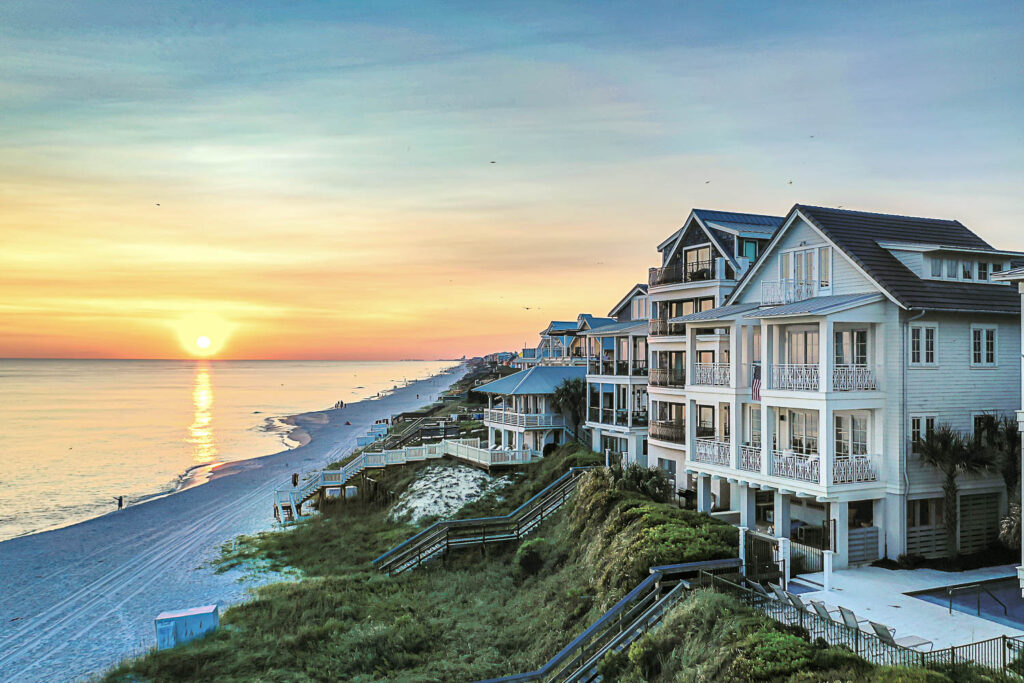
Living in the 30A area offers a unique blend of natural beauty, small-town charm, and modern amenities. This coastal paradise is known for its stunning beaches, vibrant communities, and a wide range of activities that cater to all lifestyles. Here’s an overview of what makes living in 30A so special, highlighting local attractions, events, and testimonials from residents and homeowners.
OVERVIEW OF THE LIFESTYLE AND AMENITIES AVAILABLE IN 30A COMMUNITIES
The 30A area is renowned for its laid-back lifestyle, which is perfect for those looking to escape the hustle and bustle of city life. Residents enjoy a slower pace of life, with plenty of opportunities for outdoor recreation and relaxation. Each community within 30A offers its own unique set of amenities, but there are some common features that make this area a desirable place to live:
- Pristine Beaches: The area boasts some of the most beautiful white-sand beaches in the world, with clear turquoise waters perfect for swimming, snorkeling, and paddleboarding.
- Scenic Trails and Parks: There are numerous parks and nature trails, ideal for hiking, biking, and bird-watching. Popular spots include Grayton Beach State Park and Topsail Hill Preserve State Park.
- Charming Town Centers: Many communities feature quaint town centers with boutique shops, gourmet restaurants, and cafes. Places like Seaside and Rosemary Beach are known for their vibrant downtown areas.
- Art and Culture: The 30A area has a thriving arts scene, with galleries, live music, and cultural festivals happening year-round. The Seaside Repertory Theatre and the annual 30A Songwriters Festival are just a couple of highlights.
- Wellness and Fitness: Residents have access to a variety of wellness and fitness facilities, including yoga studios, gyms, and spas. Outdoor fitness classes on the beach are also popular.
- Family-Friendly Activities: From playgrounds and community pools to family-friendly events and activities, 30A is a great place for families with children.
HIGHLIGHTING LOCAL ATTRACTIONS, EVENTS, AND ACTIVITIES
Local Attractions:
- Eden Gardens State Park: This historic park features beautiful gardens, walking trails, and the Wesley Mansion, offering a glimpse into the area’s history.
- The Blue Mountain Beach: Known for its unique geological features and the highest elevation on the Gulf Coast, it’s a great spot for hiking and enjoying panoramic views.
- The Hub: Located in Watersound, The Hub is a popular spot for dining, shopping, and entertainment, with live music and outdoor movie nights.
- Rosemary Beach Farmers Market: Held every Sunday, this market features local produce, artisanal goods, and live music, providing a vibrant community gathering place.
- Alys Beach Nature Trail: This scenic trail offers a peaceful retreat for nature lovers, winding through lush landscapes and along serene waterways.
- Seaside Amphitheater: Known for its outdoor concerts and movie nights, the Seaside Amphitheater is a hub of activity and entertainment.
Events and Activities:
- 30A Songwriters Festival: This annual event draws music lovers from all over, featuring performances by renowned singer-songwriters in various venues along 30A.
- Digital Graffiti at Alys Beach: An innovative festival where artists project their digital artwork onto the white walls of Alys Beach, creating a stunning visual experience.
- Seaside Farmers Market: Held every Saturday, this market offers fresh produce, local crafts, and delicious food, fostering a strong sense of community.
- Sandestin Wine Festival: A premier event for wine enthusiasts, featuring wine tastings, dinners, and live entertainment.
Living in the 30A area offers a unique lifestyle that combines the beauty of the Gulf Coast with the charm of small-town living. Whether you’re drawn to the vibrant town centers, the pristine beaches, or the tight-knit communities, there’s something for everyone in 30A. At Grahame Family 30A Custom Home Builders, we’re committed to helping you create a home that allows you to fully enjoy all that this exceptional area has to offer.
Testimonials from Residents and Homeowners





CONCLUSION
Building a custom home in the 30A area offers numerous benefits, from enjoying a relaxed, coastal lifestyle to living in a community with rich amenities and natural beauty.
At Grahame Family 30A Custom Home Builders, we are committed to exceeding standard building codes, ensuring your home is not only beautiful but also safe, durable, and energy-efficient. Our personalized approach and dedication to quality craftsmanship make us the perfect partner for creating your dream home in 30A.
